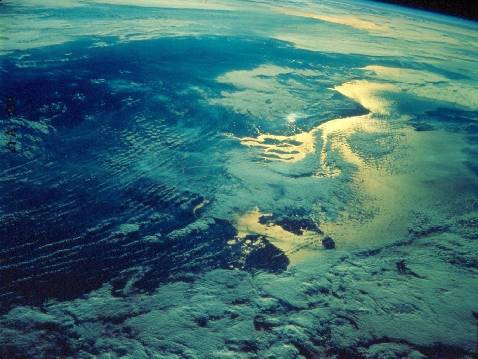The publication of the Mars halo on this site stimulates me to dig in history. On 27 April 1975, I saw by change a picture of a subsun taken from space ( 1 ). It is here on the frontal system on the right of Greenland. It was taken by the satellite ESSA 8, which was the last weather satellite that took real pictures of the Earth rather than being a scanning platform. Only a few months later, ESSA 8 was lost, so I had been very lucky. The discovery of the subsun on a satellite picture gave me the same sensation as the discovery of the subsun on Mars, 31 years later.
In 1985, I got another subsun taken from space (see photo on top), taken by the Dutch astronaut Ockels from the Challenger space shuttle during its last flight before the crash. The subsun is visible over the Netherlands, viewed upside down. Interestingly, the astronaut had overlooked the subsun despite the fact that I had prepared him for this possibility. He only saw the thing when he gave a slide show and I put his attention to it. Note its white colour compared to the sun’s reflection in the sea. Contrary to the ESSA 8 subsun on which I wrote a short paper in Weather, I did not publish this one.
Text: Günther Können

I read from TapeMoilanen that Huygens was equipped with camera for halo photography and at the time of writing (2005) it was not yet clear if any halos were captured. What's the latest on the issue?
ReplyDeleteNo halos were captured by Huygens. At a certain stage of the descent Huygens went through a cloud of methane crystals, but at that moment the sky was overcast so no halo could be created. We knew that it had been a long shot to go for Titan halos, so we were not to much disappointed - it had been fun to predict all posible shapes. I had nearly given up that there would ever be a bright 'exohalo' seen on one of the planets, so the surprize was great when I saw suddenly the subsun on Mars, about one year later.
ReplyDelete